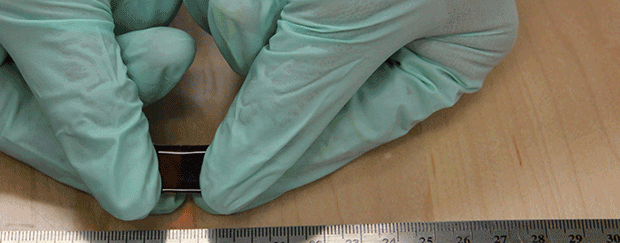When you pull a muscle, it may hurt like heck for a while, but the human body can heal. The same is not true of the electrically-responsive polymers used to make artificial muscles for haptic systems and experimental robots. When they get cut or punctured, it’s game over.
A new polymer that’s super stretchy and self-healing can act as a more resilient artificial muscle material. Created by a team led by Stanford University materials scientist Zhenan Bao, the polymer has an unusual combination of properties. A 2.5-centimeter sheet of the stuff can be stretched out to a length of 2.5 meters. When it’s punctured it fuses back together, something other self-healing materials don’t do well in ambient conditions.
This version of the material is not going to power a robot to win any weight-lifiting contests: it generates just a small amount of force, expanding by 3.6 percent under an electric field of 17.2 millivolts per meter. (The muscle expands in one dimension, contracting in the other two.)
Artificial muscles contract in response to an electric field, similar to biological muscles, but they’re typically made of polymers. They’re found in some cell phone haptic feedback systems. They can also be used to make robot appendages move and to push up and down the Braille dots in displays for people with low vision.
“Artificial muscles are typically very sensitive to defects and pinholes—they really affect their actuation performance,” says Bao.
The Stanford group wanted to make artificial muscles that would more readily heal. Bao is known for developing more sensitive, more life-like electronic skin for robotics and prosthetics, and the new chemical design basics will help make better materials for those efforts. But she has a broader goal of learning how to better engineer multifunctional materials.

The idea behind the project is not to create the world’s strongest artificial muscle, says Bao, but to learn how to engineer polymers with totally new combinations of properties—in this case, very stretchy self-healing material that’s electrically responsive.
The chemistry of the new polymer makes it highly adaptable to that application. It has a combination of strong bonds, which give it mechanical strength, and weak ones, which break and form easily. The material is made up of a tangled network of long polymer chains based on the common elastomer PDMS. The Stanford group added iron-containing molecules and ones that bind to that iron. When the iron bonds are broken by cutting or stretching, new ones seem to form instantaneously. Bao’s group describes the new material today in the journal Nature Chemistry.
Other self-healing polymers will only reform under stringent conditions. Those healed by weak hydrogen bonds are sensitive to water vapor in the air. In contrast, the Stanford material can sit out in open air for days without any damage. Other designs have to be heated or compressed to trigger the reforming reactions; the Stanford elastomer heals at room temperature without any extra nudging. And once it reforms, its electric and mechanical properties are as good as they were before.
The material’s extreme stretchiness is an unexpected bonus—the researchers were only intending to make an elastomer that heals more readily. It turns out that this rapid breaking and reforming of bonds also enables the material to recover after being pulled to extremes. The polymer can accommodate strains up to 10,000 percent. It’s so stretchy that the mechanical-testing equipment on hand in the lab was not big enough to pull it as far as it would go—two students had to tug the material across the room.
Bao says artificial muscles are just one possible application for these sorts of materials. They’re now applying this simultaneous break-and-repair chemistry to other kinds of electronic polymers. “We want to build electronic circuits that are self-healing,” she says. Right now she’s working on creating stretchy self-healing polymers with the right electronic properties to make the different parts of a full transistor—semiconductors, conductors, and dielectric materials. These might be used in resilient electronic skin for robots and prosthetics.
Katherine Bourzac is a freelance journalist based in San Francisco, Calif. She writes about materials science, nanotechnology, energy, computing, and medicine—and about how all these fields overlap. Bourzac is a contributing editor at Technology Review and a contributor at Chemical & Engineering News; her work can also be found in Nature and Scientific American. She serves on the board of the Northern California chapter of the Society of Professional Journalists.



